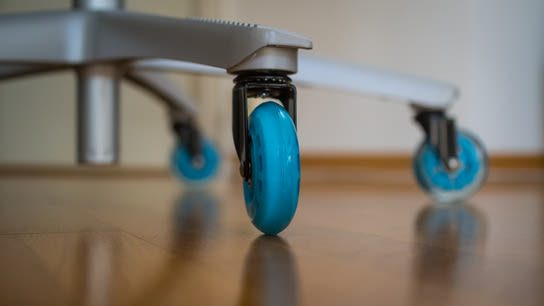I swapped out my boring old office chair double-wheeled castors for rollerblade-style wheels. I didn’t quite know what I expected, but I’m happier with my chair. The new wheels also as the potential for a minuscule improve my health; so what’s not to like? Here are some of the unexpected benefits of replacing the wheels on my office chair.
A couple of months ago, I stumbled upon rollerblade-style wheels as an upgrade for office chairs. I’ve never cared much about my office chair even though I sit hours in it every day. I haven’t got a fancy office chair, just a basic model from IKEA. I don’t know why a new set of wheels appealed to me, but I know I wanted to give it a go. It was just something different.
They’re attached using a standard method that means most wheels will work on most chairs across brands. Most office chairs are compatible with one of two standard wheel stem/pin sizes: 11 mm (most brands) or 10 mm (IKEA). You just pull out the old wheels and stick in the replacement wheels. I somehow imagined that the whole chair was a single unit, and haven’t ever given much thought to how the wheels work. I must have known this when I assembled my IKEA chair, but I must have forgotten it in the decade since.
Rollerblade-style wheels cost about 25 USD, available from major retailers. These wheels are sometimes marketed as “gaming wheels”. Brands also apply the “gaming” label to chewing gum and plain bottled water, so it really doesn’t mean anything anymore.
So, how much difference does a new set of wheels make? It makes a surprising amount of difference in different situations. I’ll start with the most obvious ones and work my way through the list.
Most traditional office chair wheels are designed to sit in one place unless you apply force to move it. Rollerblade wheels can move freely, and the only resistance coming from the wheels having to turn in-place to accommodate directional changes. This might sound like an undesirable effect at first glance. Even small movements can easily send you a couple of centimeters off in one direction.
If you’re reading this blog, then you’re probably spending way too many hours of the day sitting. It’s difficult to sit completely still with rollerblade wheels. I don’t find myself constantly fidgeting on the chair. However, it does require me to exert some extra energy throughout the day to move it back into position. This was distracting the first couple of days, but now I do it subconsciously.
This won’t replace exercise and a healthy lifestyle, but it probably doesn’t hurt either. I found a much-cited research study on standing-desks versus sitting-desks where researchers compared the blood glucose levels of office workers using either type of desk. Glucose level is a key health metric. Any amount of physical activity can help regulate glucose levels, and standing desks are known to increases the levels of low-level physical activity. Workers in the study saw improved post-meal glucose levels when using the standing desk compared to sitting.
You’ll need a walking desk if you want to lose weight. Neither a standing-desk nor a wheel upgrade for your chair will come anywhere near the heart-rate and activity levels you get from even light exercise. Extrapolating from the study, I assume that the extra movements encouraged by the rollerblade-wheels can help me — as a diabetic — regulate my glucose levels. It probably won’t help a whole lot, but it might help a little.
My chair is still comfortable to sit in. It hasn’t suddenly turned into the deliberately-uncomfortable Focus Master chair from Better Off Ted. It feels great, and the wheels never get stuck when I try to move it. After swapping out the wheels, it sometimes rolls off to the other side of the room when I get up. It just requires a little more effort to keep it in one spot.
I’ve found that the new wheels also help me maintain a good sitting posture. I must sit with my feet firmly planted on the ground, or I’ll risk pushing myself off from the desk with small movements such as retrieving the phone from my pocket.
Many product listings for rollerblade-wheels claim that they’re easier on most floor surfaces than traditional wheels. They definitely have a smaller contact area with the floor, and the reduced resistance helps avoid skid marks on the floor. It sounds logical, but I don’t have any way to evaluate this claim.
A more unexpected side-effect is that I never need to get off my chair and disentangle headphone or charging cables from my chair. Traditional office chair wheels castors use two wheels side-by-side, leaving a gap in between where cables can easily get snagged. The rollerblade wheels either runs over the cables or pushes them aside.
The only drawback with rollerblade wheels is that you can’t stand and lean on your chair anymore. If casual chair-leaning is your thing, then rollerblade-style wheels might not be for you. It can also injure others who lean on your chair and expect it to behave like a regular chair.
